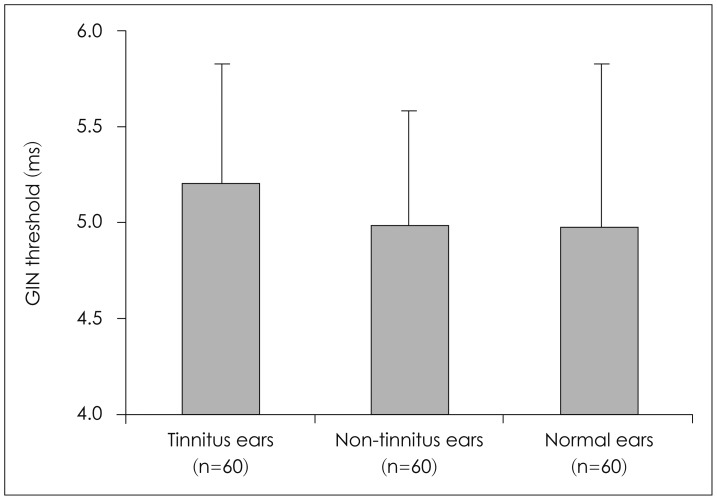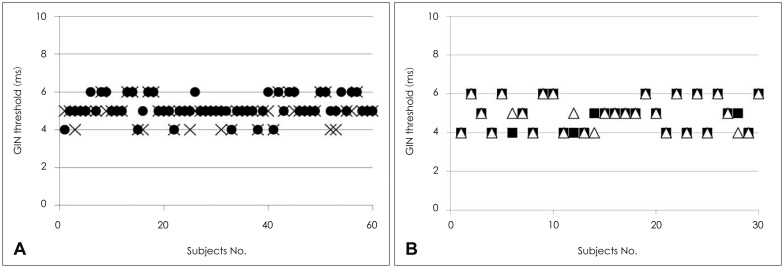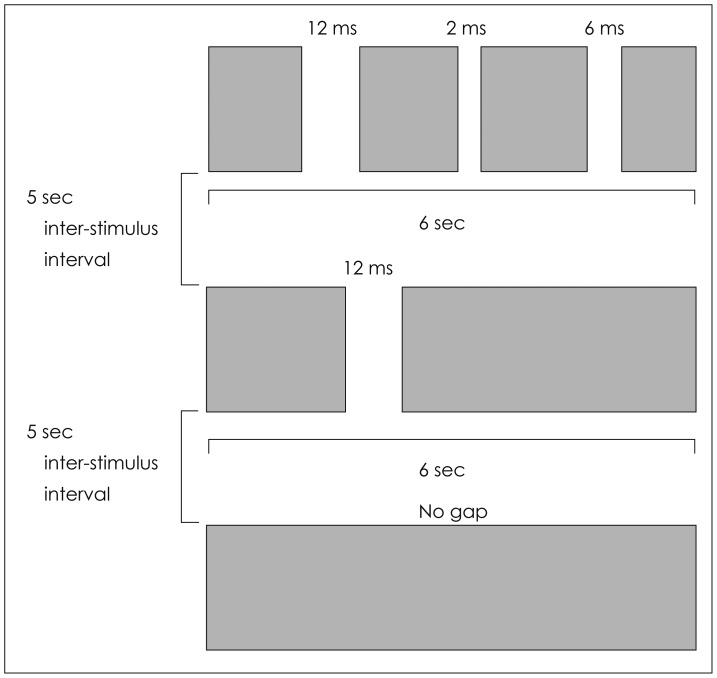单侧耳鸣对听觉时间分辨率的影响:噪声间隙性能。
Korean journal of audiology
Pub Date : 2014-12-01
Epub Date: 2014-12-22
DOI:10.7874/kja.2014.18.3.119
引用次数: 14
摘要
背景和目的:噪音间隙(GIN)测试是一种评估听觉时间分辨率的方法,听觉时间分辨率是一种跟踪声音刺激包络随时间快速变化的能力。我们研究了单侧耳鸣是否会通过GIN性能影响时间分辨率。对象和方法:对60例单侧耳鸣患者120耳进行听力测试,包括GIN测试,这些患者的听力在20 dB HL差至8 kHz的范围内对称(耳鸣影响耳,14.6±11.2 dB HL;非耳鸣耳(15.1±11.5 dB HL),听力正常者30例60耳。比较耳鸣侧和非耳鸣侧患者与正常耳的对照。结果:耳鸣耳(5.18±0.6 ms)、非耳鸣耳(4.98±0.6 ms)和正常耳(4.97±0.8 ms)的平均GIN阈值差异无统计学意义。耳鸣侧平均正确率(67.3±5.5%)略低于非耳鸣侧(70.0±5.5%),与正常耳(69.4±7.5%)差异无统计学意义。耳鸣耳的GIN阈值和GIN感知水平与性别、耳鸣的频率和响度以及听力学数据无关。年龄仅与GIN表现有显著相关。结论:我们没有发现单侧耳鸣影响听觉时间分辨的证据。这些结果表明,耳鸣可能不仅仅是填补了背景噪音中无声的空白。本文章由计算机程序翻译,如有差异,请以英文原文为准。



The effects of unilateral tinnitus on auditory temporal resolution: gaps-in-noise performance.
Background and Objectives The Gaps-In-Noise (GIN) test is a measure to assess auditory temporal resolution, which is the ability to follow rapid changes in the envelope of a sound stimulus over time. We investigated whether unilateral tinnitus affects temporal resolution by the GIN performance. Subjects and Methods Hearing tests including the GIN test were performed in 120 ears of 60 patients with unilateral tinnitus who showed symmetric hearing within 20 dB HL difference up to 8 kHz (tinnitus-affected ears, 14.6±11.2 dB HL; non-tinnitus ears 15.1±11.5 dB HL) and 60 ears of 30 subjects with normal hearing. Comparisons were made between tinnitus and non-tinnitus side of patients and normal ears of controls. Results There was no significant difference of the mean GIN thresholds among tinnitus-affected ears (5.18±0.6 ms), non-tinnitus ears (4.98±0.6 ms) and normal ears (4.97±0.8 ms). The mean percentage of correct answers in tinnitus side (67.3±5.5%) was slightly less than that in non-tinnitus side (70.0±5.5%) but it was not significantly different from that in normal ears (69.4±7.5%). Neither the GIN threshold nor the GIN perception level in tinnitus ears has relation to sex, frequency and loudness of tinnitus, and audiometric data. Age only showed a significant correlation with the GIN performance. Conclusions We found no evidence which supported the influence of unilateral tinnitus on auditory temporal resolution. These results imply that tinnitus may not simply fill in the silent gaps in the background noise.
求助全文
通过发布文献求助,成功后即可免费获取论文全文。
去求助

 求助内容:
求助内容: 应助结果提醒方式:
应助结果提醒方式:


